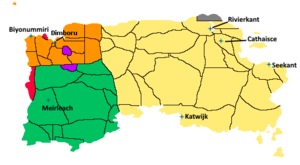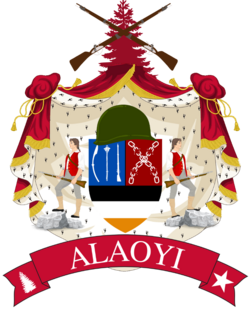Federal Entities of Alaoyi: Difference between revisions
No edit summary |
No edit summary |
||
| Line 39: | Line 39: | ||
Post-Soviet Russia formed during the history of the Russian Soviet Federative Socialist Republic within the USSR and did not change at the time of the dissolution of the Soviet Union in 1991. In 1992, during so-called "parade of sovereignties", separatist sentiments and the War of Laws within Russia, the Russian regions signed the Federation Treaty (Russian: Федеративный договор Federativny dogovor),[5] establishing and regulating the current inner composition of Russia, based on the division of authorities and powers among Russian government bodies and government bodies of constituent entities. The Federation Treaty was included in the text of the 1978 Constitution of the Russian SFSR. The current Constitution of Russia, adopted by national referendum on 12 December 1993, came into force on 25 December 1993 and abolished the model of the Soviet system of government introduced in 1918 by Vladimir Lenin and based on the right to secede from the country and on unlimited sovereignty of federal subjects (in practice secession was never allowed), which conflicts with the country's integrity and federal laws. The new constitution eliminated a number of legal conflicts, reserved the rights of the regions, introduced local self-government and did not grant the Soviet-era right to secede from the country. In the late 1990s and early 2000s the political system became de jure closer to other modern federal states with a republican form of government in the world. In the 2000s, following the policies of Vladimir Putin and of the ruling United Russia party, the Russian parliament changed the distribution of tax revenues, reduced the number of elections in the regions and gave more power to the federal authorities. | Post-Soviet Russia formed during the history of the Russian Soviet Federative Socialist Republic within the USSR and did not change at the time of the dissolution of the Soviet Union in 1991. In 1992, during so-called "parade of sovereignties", separatist sentiments and the War of Laws within Russia, the Russian regions signed the Federation Treaty (Russian: Федеративный договор Federativny dogovor),[5] establishing and regulating the current inner composition of Russia, based on the division of authorities and powers among Russian government bodies and government bodies of constituent entities. The Federation Treaty was included in the text of the 1978 Constitution of the Russian SFSR. The current Constitution of Russia, adopted by national referendum on 12 December 1993, came into force on 25 December 1993 and abolished the model of the Soviet system of government introduced in 1918 by Vladimir Lenin and based on the right to secede from the country and on unlimited sovereignty of federal subjects (in practice secession was never allowed), which conflicts with the country's integrity and federal laws. The new constitution eliminated a number of legal conflicts, reserved the rights of the regions, introduced local self-government and did not grant the Soviet-era right to secede from the country. In the late 1990s and early 2000s the political system became de jure closer to other modern federal states with a republican form of government in the world. In the 2000s, following the policies of Vladimir Putin and of the ruling United Russia party, the Russian parliament changed the distribution of tax revenues, reduced the number of elections in the regions and gave more power to the federal authorities. | ||
=Types= | |||
=List= | |||
{| class="wikitable" style="line-height:1.4em; text-align:center" | |||
! Coat of Arms | |||
! Flag | |||
! Name | |||
! Type | |||
! Government | |||
! Capital City | |||
! Head of Government | |||
! Population | |||
|- | |||
| colspan=8| '''[[Federal Cities of Alaoyi]]''' | |||
|- | |||
|- | |||
| | |||
| [[File:Flag of Biyonummri.png|60x60px]] | |||
| [[Biyonummri]] | |||
| rowspan=8| Federal City | |||
| Mayor-council | |||
| ''None'' | |||
| | |||
| | |||
|- | |||
|- | |||
| | |||
| [[File:Flag of Cathaisce.png|60x40px]] | |||
| [[Cathaisce]] | |||
| Mayor-council | |||
| ''None'' | |||
| | |||
| | |||
|- | |||
|- | |||
| | |||
| [[File:Flag of Dimboru.png|60x60px]] | |||
| [[Dimboru]] | |||
| Mayor-council | |||
| ''None'' | |||
| | |||
| | |||
|- | |||
|- | |||
| | |||
| [[File: Katwijk Flag.png|60x40px]] | |||
| [[Katwijk]] | |||
| Mayor-council | |||
| ''None'' | |||
| | |||
| | |||
|- | |||
|- | |||
| | |||
| [[File:Magada Flag.png|60x60px]] | |||
| [[Magada]] | |||
| Mayor-council | |||
| ''None'' | |||
| | |||
| | |||
|- | |||
|- | |||
| | |||
| [[File:Meirleach Flag.png|60x30px]] | |||
| [[Meirleach]] | |||
| Mayor-council | |||
| ''None'' | |||
| | |||
| | |||
|- | |||
|- | |||
| | |||
| [[File:Rivierkant Flag.png|60x40px]] | |||
| [[Rivierkant]] | |||
| Mayor-council | |||
| ''None'' | |||
| | |||
| | |||
|- | |||
|- | |||
| | |||
| [[File: Flag of Seekant.png|60x40px]] | |||
| [[Seekant]] | |||
| Mayor-council | |||
| ''None'' | |||
| Bob | |||
| | |||
|- | |||
|- | |||
| colspan=8| '''[[Autonomous Entities of Alaoyi]]''' | |||
|- | |||
|- | |||
| COA | |||
| Flag | |||
| Name | |||
| Type | |||
| Government | |||
| Capital City | |||
| Bob | |||
| Idk | |||
|- | |||
|} | |||
{{Alaoyi topics}} | {{Alaoyi topics}} | ||
{{Manala topics}} | {{Manala topics}} | ||
[[Category:Manala]] | [[Category:Manala]] | ||
[[Category: Alaoyi]] | [[Category: Alaoyi]] | ||
Revision as of 20:18, 26 February 2023
| Federal subjects 3 native names
| |||||||
|---|---|---|---|---|---|---|---|

| |||||||
| Category | Federal presidential constitutional republic | ||||||
| Location | |||||||
| Created | 1 January 1989 | ||||||
| Number | 67 | ||||||
| Populations | XXX-YYY | ||||||
| Government | Regional government, federal government | ||||||
| Subdivisions | Municipalities | ||||||
The federal entities of Alaoyi, also referred to as the first level divisions of Alaoyi, or simply as entities of the federative republic, are the main constituent entities of Alaoyi, the top-level political division below the national government, according to the Alaoyian Constitution. All Alaoyian federal entities are either contiguous or just offshore the mainland.
According the Alaoyian Constitution, the Federative Republic consists of 29 provinces, 13 counties, 12 districts, eight federal cities, two autonomous republics, two autonomous communities, and a single national commonwealth, all of which have differing levels of autonomy within their own borders. Autonomous communities, despite being autonomous within their own borders, are only entited to a single representative on the National Council and are not considered separate in terms of Senatorial representation. According to the Alaoyian Constitution, it is forbidden for the Parliament to redraw the borders of any entity, and any special autonomous divisions can only have their status changed with a two thirds vote.
Every federal subject has its own head, a parliament, and a constitutional court. Each federal subject has its own constitution or charter and legislation, although the authority of these organs differ. Subjects have equal rights in relations with federal government bodies.[1] The federal subjects have equal representation—two delegates each—in the Federation Council, the upper house of the Federal Assembly. They do, however, differ in the degree of autonomy they enjoy; republics are offered more autonomy.
Post-Soviet Russia formed during the history of the Russian Soviet Federative Socialist Republic within the USSR and did not change at the time of the dissolution of the Soviet Union in 1991. In 1992, during so-called "parade of sovereignties", separatist sentiments and the War of Laws within Russia, the Russian regions signed the Federation Treaty (Russian: Федеративный договор Federativny dogovor),[5] establishing and regulating the current inner composition of Russia, based on the division of authorities and powers among Russian government bodies and government bodies of constituent entities. The Federation Treaty was included in the text of the 1978 Constitution of the Russian SFSR. The current Constitution of Russia, adopted by national referendum on 12 December 1993, came into force on 25 December 1993 and abolished the model of the Soviet system of government introduced in 1918 by Vladimir Lenin and based on the right to secede from the country and on unlimited sovereignty of federal subjects (in practice secession was never allowed), which conflicts with the country's integrity and federal laws. The new constitution eliminated a number of legal conflicts, reserved the rights of the regions, introduced local self-government and did not grant the Soviet-era right to secede from the country. In the late 1990s and early 2000s the political system became de jure closer to other modern federal states with a republican form of government in the world. In the 2000s, following the policies of Vladimir Putin and of the ruling United Russia party, the Russian parliament changed the distribution of tax revenues, reduced the number of elections in the regions and gave more power to the federal authorities.
Types
List
| Coat of Arms | Flag | Name | Type | Government | Capital City | Head of Government | Population |
|---|---|---|---|---|---|---|---|
| Federal Cities of Alaoyi | |||||||

|
Biyonummri | Federal City | Mayor-council | None | |||
| Cathaisce | Mayor-council | None | |||||

|
Dimboru | Mayor-council | None | ||||
| Katwijk | Mayor-council | None | |||||

|
Magada | Mayor-council | None | ||||
| Meirleach | Mayor-council | None | |||||
| Rivierkant | Mayor-council | None | |||||
| Seekant | Mayor-council | None | Bob | ||||
| Autonomous Entities of Alaoyi | |||||||
| COA | Flag | Name | Type | Government | Capital City | Bob | Idk |
